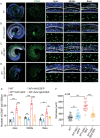Viral-Mediated Connexin 26 Expression Combined with Dexamethasone Rescues Hearing in a Conditional Gjb2 Null Mice Model
- PMID: 39739601
- PMCID: PMC12362743
- DOI: 10.1002/advs.202406510
Viral-Mediated Connexin 26 Expression Combined with Dexamethasone Rescues Hearing in a Conditional Gjb2 Null Mice Model
Abstract
GJB2 encodes connexin 26 (Cx26), the most commonly mutated gene causing hereditary non-syndromic hearing loss. Cx26 is mainly expressed in supporting cells (SCs) and fibrocytes in the mammalian cochlea. Gene therapy is currently considered the most promising strategy for eradicating genetic diseases. However, there have been no significant effects of gene therapy for GJB2 gene mutation-associated deafness because deficiency of Cx26 leads to expanded sensory epithelial damage. In this study, the AAV2.7m8 serotype combined with the gfaABC1D promoter targeted infection of SCs is identified. It is found that Gjb2 gene replacement therapy in wild-type mice results in sensory hair cells (HCs) deficits, excessive inflammatory responses, and hearing loss. This may be one of the key factors contributing to the hardship of GJB2 gene replacement therapy. Dexamethasone (DEX) shows promising results in inhibiting macrophage recruitment, with a protective effect against HC damage. Further, the combination of AAV2.7m8-Gjb2 with DEX shows a synergistic effect and enhances the gene therapy effect in a conditional Cx26 null mice model. These results indicate that the combination of gene therapy and medication will provide a new strategy for the treatment of hereditary deafness associated with GJB2 defects.
Keywords: AAV2.7m8; GJB2; dexamethasone; gene therapy; hearing loss.
© 2024 The Author(s). Advanced Science published by Wiley‐VCH GmbH.
Conflict of interest statement
The authors declare no conflict of interest.
Figures







Similar articles
-
Combined AAV-mediated specific Gjb2 expression restores hearing in DFNB1 mouse models.Mol Ther. 2025 Jul 2;33(7):3006-3021. doi: 10.1016/j.ymthe.2025.03.029. Epub 2025 Mar 22. Mol Ther. 2025. PMID: 40121530
-
Abnormal Innervation, Demyelination, and Degeneration of Spiral Ganglion Neurons as Well as Disruption of Heminodes are Involved in the Onset of Deafness in Cx26 Null Mice.Neurosci Bull. 2024 Aug;40(8):1093-1103. doi: 10.1007/s12264-023-01167-x. Epub 2024 Feb 4. Neurosci Bull. 2024. PMID: 38311706 Free PMC article.
-
Epidemiology, etiology, genetic variants in non- syndromic hearing loss in Iran: A systematic review and meta-analysis.Int J Pediatr Otorhinolaryngol. 2023 May;168:111512. doi: 10.1016/j.ijporl.2023.111512. Epub 2023 Mar 29. Int J Pediatr Otorhinolaryngol. 2023. PMID: 37086676
-
Promotion of new expression of connexin gene Cx46 ( GJA3 ) in the cochlea after Cx26 ( GJB2 ) deficiency.bioRxiv [Preprint]. 2025 Apr 3:2025.03.30.646179. doi: 10.1101/2025.03.30.646179. bioRxiv. 2025. PMID: 40236035 Free PMC article. Preprint.
-
The Black Book of Psychotropic Dosing and Monitoring.Psychopharmacol Bull. 2024 Jul 8;54(3):8-59. Psychopharmacol Bull. 2024. PMID: 38993656 Free PMC article. Review.
Cited by
-
Retrospective study on endoscopic treatment of recurrent esophageal cancer patients after radiotherapy.Surg Endosc. 2024 Nov;38(11):6637-6642. doi: 10.1007/s00464-024-11259-y. Epub 2024 Sep 18. Surg Endosc. 2024. PMID: 39294315
References
-
- Smith R. J., J. F. Bale Jr., White K. R., Lancet 2005, 365, 879. - PubMed
MeSH terms
Substances
Grants and funding
- 82430035/Key Program of the National Natural Science Foundation of China
- 82301325/National Natural Science Foundation of China
- 82301323/National Natural Science Foundation of China
- 82301324/National Natural Science Foundation of China
- 82071058/National Natural Science Foundation of China
- 2021YFF0702303/National Key Research and Development Program of China
- 2023YFE0203200/National Key Research and Development Program of China
- 2023AFA038/Foundation for Innovative Research Groups of Hubei Province
- 2024BRA019/Basic Research Support Program of Huazhong University of Science and Technology
LinkOut - more resources
Full Text Sources
Medical
